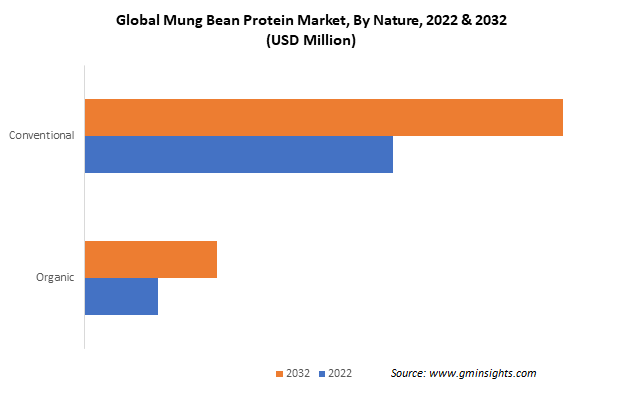Home > Food & Beverages > Proteins > Plant-Based Proteins > Mung Bean Protein Market
Mung Bean Protein Market Analysis
- Report ID: GMI5232
- Published Date: Nov 2022
- Report Format: PDF
Mung Bean Protein Market Analysis
With regard to the product category, mung bean protein market from isolate segment is expected to garner over USD 220 million by 2032. Mung bean isolate is widely used as a direct protein replacement for vegetable or animal-based protein in a range of conventional food & beverages across multiple categories. The growing popularity of plant protein and the increasing product utilization as a meat additive owing to its high nutritional value and delicious flavor will propel segment revenues during the study timeframe.

Regarding nature, mung bean protein market conventional segment is predicted to be worth over USD 300 million by 2032. Conventional mung bean protein finds significant usage in functional foods, bakery goods, salty snacks, and confectionery products due to its rich nutritional composition and adaptable character. They contain a variety of Vitamin B variants, such as niacin, pantothenic acid, biotin, thiamin, etc., which help improve body energy levels. The accelerating consumer inclination toward natural food products, aided by rising health concerns, will create favorable growth prospects for the mung bean protein industry.

Based on applications, mung bean protein market size from food & beverage applications is anticipated to be worth over USD 110 million by 2032. The considerable change in consumer dietary patterns has shifted their preference toward conventional food products over synthetic ones. This has resulted in the inclusion of mung bean protein derivatives in a range of food & beverage products, such as sweets, soups, sauces, baked goods, etc. The increasing popularity of organic products due to their positive health impacts will further drive segment revenues over the coming years.

Asia Pacific mung bean protein marker is set to witness over 3.5% CAGR between 2023 and 2032. The increasing technological advancements and the growing adoption of modern farming techniques across countries such as India have significantly improved mung bean cultivation and yields. Governments across the region have been running several assistance programs and subsidy schemes to encourage farming practices, which will greatly contribute to regional market expansion.

